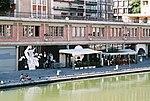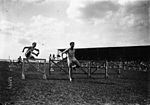The Gibbet of Montfaucon (French: Gibet de Montfaucon) was the main gallows and gibbet of the Kings of France until the time of Louis XIII of France. It was used to execute criminals, often traitors, by hanging and to display their dead bodies as a warning to the population. It was a large structure located at the top of a small hill near the modern Place du Colonel Fabien in Paris, though during the Middle Ages it was outside the city walls and the surrounding area was mostly not built up, being occupied by institutions like the Hôpital Saint-Louis from 1607, and earlier the Convent of the Filles-Dieu ("Daughters of God"), a home for 200 reformed prostitutes, and the leper colony of St Lazare.First built in the late 13th century, it was used until 1629 and then dismantled in 1760. As reconstructed in images by Eugène Viollet-le-Duc it had three sides, and 45 compartments in which people could be both hanged and hung after execution elsewhere. A miniature of about 1460 from the Grandes Chroniques de France by Jean Fouquet, and also a print of 1609, show a somewhat less substantial structure than that in the reconstructions, which may, like others by Viollet-le-Duc, make the structure grander and more complex than was actually the case. The miniature shows bodies hanging from beams running across the central space, resting on the piers, but Viollet-le-Duc shows slabs running round the sides. Both show a substantial platform in masonry, which ran round a central space at ground level in the reconstructions, entered by a tunnel through the platform, closed by a gate. Another print of 1608 shows only two tiers of compartments rather than the three of Viollet-le-Duc. The English travel writer Thomas Coryat saw it at about the same time and described it as "the fayrest gallowes that I ever saw, built on a little hillocke ... [with] fourteen pillars of free stone".The structure was also used for displaying the bodies of those executed elsewhere; in 1416 the remains of Pierre des Essarts were finally handed back to his family after three years at Montfaucon. Like an alarming number of other victims, Essarts had been one of the four royal treasurers.
The gibbet was a great favourite of popular historians and historical writers of the 19th century, appearing in historical novels including The Hunchback of Notre-Dame (1831) by Victor Hugo, Crichton (1837) by William Harrison Ainsworth, and La Reine Margot (1845) by Alexandre Dumas; both the last two tales centred on the St. Bartholomew's Day Massacre.











